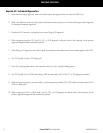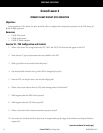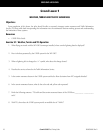
Garmin G1000 Pilot’s Training Guide
190-00368-00 Rev. D
21
APPENDIX
THE G1000 INTEGRATED AVIONICS SYSTEM AND CONSIDERATIONS OF ITS USE TO ENHANCE THE
AERONAUTICAL DECISION MAKING (ADM) PROCESS AND SINGLE-PILOT RESOURCE MANAGEMENT
(SRM).
The Garmin G1000 Integrated Avionics System has brought a number of improvements in cockpit technology to the General
Aviation (GA) aircraft. These improvements range from longer life and greater reliability of the primary instruments to a simpli-
fied pilot interface. With the addition of new technologies, the G1000 system is capable of providing the pilot with a wider variety
of information about the flight environment, thereby leading to greater situational awareness and reduced pilot workload. The
G1000 system allows the pilot to focus on aeronautical decision making (ADM) and single-pilot resource management (SRM).
The majority of GA flight operations are single-pilot operations. The single-pilot, IFR, cross-country flight is often regarded as
one of the most challenging flight operations. The need to communicate and navigate while relying solely on the aircraft instru-
ments makes the single-pilot cockpit a busy and stressful environment. Since the inability to manage these demands effectively
can prove life threatening, understanding and using all of the tools available in the cockpit is key to overcoming the challenges
presented by single-pilot IFR flights.
The autopilot is a fundamental tool that is often overlooked in the current aviation training environment. As an SRM tool,
no other piece of avionics is as valuable in reducing pilot workload as the autopilot. Pilots should routinely practice using the
autopilot and gain a full understanding of their particular system. Using the autopilot allows the pilot to focus on other flight
management tasks such as route deviation planning and general aircraft system monitoring without reaching a point of sensory
overload.
In the case of system failures or emergencies, the autopilot relieves the pilot of the workload of manually flying the aircraft and
thus allows the problem to be addressed. It is important to note that many GA aircraft are equipped with a rate-based autopilot
that receives roll inputs from an electric turn-coordinator. In aircraft equipped with a vacuum-driven attitude indicator, failure of
the vacuum pump should prompt the pilot to immediately change to a partial panel scan and to engage the autopilot in at least a
roll and pitch mode. In aircraft equipped with a GPS coupled to the autopilot, the pilot should activate GPS direct-to navigation
to the nearest suitable airport, then place the autopilot in NAV mode to fly straight to the airport. In either case, the autopilot
reduces pilot workload by helping to ensure that the wings remain level and that standard rate turns are used.
At initial release, the G1000 system will interface with the third party, rate-based autopilot installed in the aircraft. These auto-
pilots are linked to a remote-mounted rate-based gyro that is independent of the G1000 system; therefore, the above-mentioned
methodology still applies if attitude information is lost. Indeed, using the autopilot in roll-control or navigation mode at the point
of attitude failure allows the pilot to maintain control of the aircraft while taking appropriate emergency actions. Again, the use
of the autopilot reduces pilot workload and should allow the pilot to better manage the emergency. Nonetheless, it is imperative
that the pilot double-check all autopilot inputs in order to avoid mode confusion and monitor them to ensure that the intended
operation is taking place.
While the autopilot is the single most valuable tool for SRM, it is also important that the pilot develop a consistent approach
to using the communication and navigation tools present in the G1000 system. The two COM and NAV receivers combined
with the ability to tune COM and NAV frequencies from the Jeppesen database give the pilot a streamlined process for frequency
selection and management.
A typical methodology for COM/NAV frequency management is to designate COM1 and NAV1 as the primary airborne and
enroute frequencies. COM2 can then be reserved for both weather (ATIS, ASOS, AWOS) and ground frequencies. Meanwhile,
NAV2 is set as the backup to NAV1. If established as part of a standard operating procedure, these selections help to minimize
the confusion over which COM and/or NAV is selected and active. When a consistent approach to frequency management is not
used, the pilot is more likely to run into mode confusion concerning the use of the audio control panel; this can in turn lead to
missed radio calls and/or transmissions on the incorrect frequency.


















